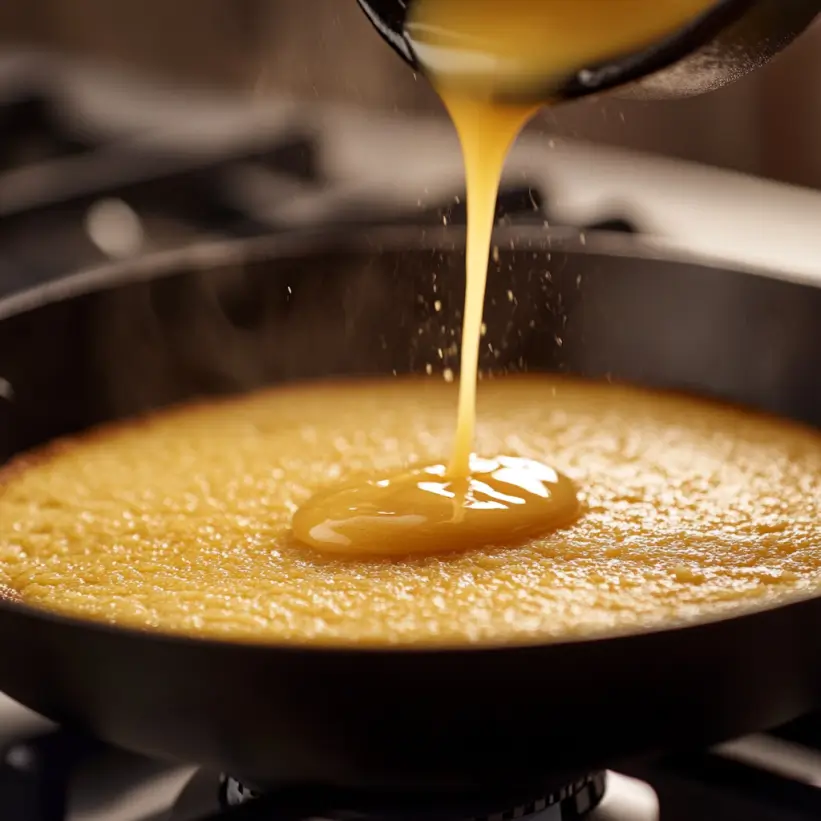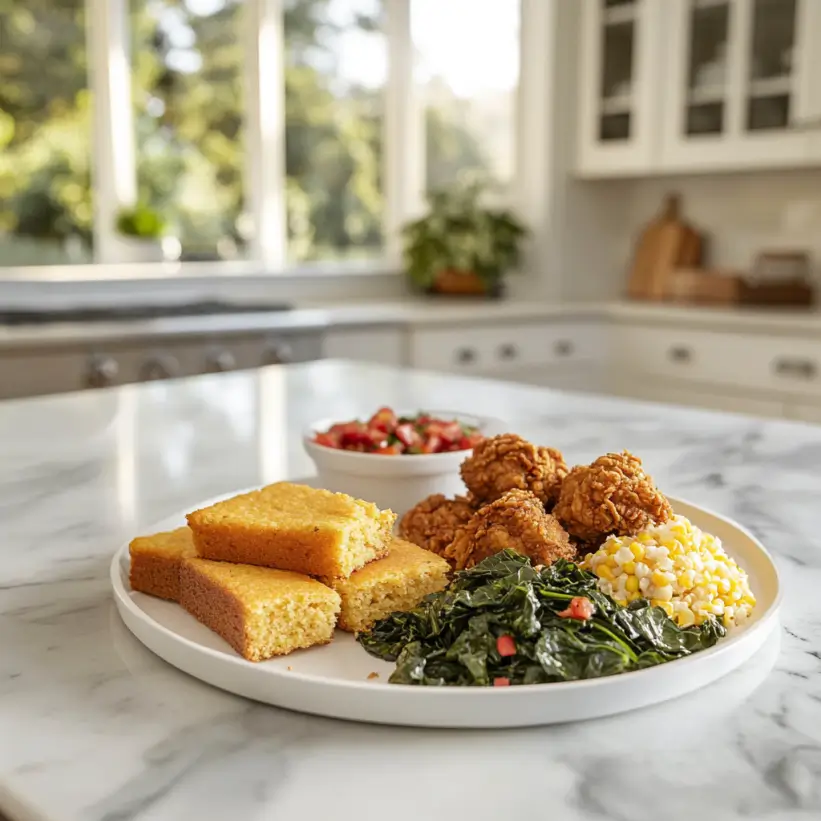Introduction: Why Southern Cornbread Stands the Test of Time
Southern cornbread isn’t just food—it’s a tradition, a memory, and a connection to the past. With its crispy crust and tender crumb, this humble dish has graced tables across the South for generations. In this article, we’ll explore the heart and soul of a traditional Southern cornbread recipe, delve into its variations, master its cooking techniques, and discover how it pairs beautifully with other Southern staples. Whether you’re new to this timeless dish or a seasoned cornbread enthusiast, you’ll walk away with a deep appreciation for its versatility and charm.
Table of Contents
Part 1: How to Make Classic Southern Cornbread
Key Ingredients in Southern Cornbread
The magic of Southern cornbread lies in its simplicity, where each ingredient has a role to play. Here’s what you’ll need to create the authentic flavor:
- Cornmeal: The star ingredient, preferably stone-ground for a rustic texture.
- Buttermilk: Adds a tangy richness and helps achieve the moist interior.
- Eggs: Binds the ingredients and contributes to the cornbread’s structure.
- Baking soda and baking powder: Provides just the right amount of lift.
- Fat: Traditionally bacon drippings, though butter or vegetable oil can also be used for flavor and moisture.
Pro tip: Stick to yellow cornmeal for a more robust flavor, but white cornmeal is also a Southern favorite.
Step-by-Step Instructions for Authentic Southern Cornbread

Let’s get into the nitty-gritty of making cornbread like a true Southerner. Follow these steps to nail it every time:
- Preheat your oven: Crank it up to 425°F. Place your cast iron skillet inside to heat.
- Prepare the batter: In a large bowl, mix your dry ingredients—cornmeal, baking soda, and a pinch of salt. In another bowl, whisk together buttermilk, eggs, and melted fat. Combine the wet and dry mixtures, stirring just until blended.
- Heat the skillet: Remove your skillet from the oven, and add a generous dollop of fat. Swirl it around to coat the pan evenly, ensuring that golden crust we all crave.
- Pour and bake: Pour the batter into the hot skillet, spreading it evenly. Bake for 20-25 minutes until the top is golden brown and a toothpick comes out clean.
- Cool and serve: Allow your cornbread to cool slightly before slicing. Enjoy warm with butter or alongside your favorite dish.
Tips for Perfect Texture and Flavor
Getting that signature crunchy crust and moist interior isn’t just luck—it’s a science. Here are a few tips to ensure your Southern cornbread is perfection:
- Don’t overmix: Stirring too much can make the cornbread dense. Keep it light and airy.
- Heat the skillet first: This step ensures a crispy, caramelized crust.
- Experiment with fat: Bacon drippings add smoky depth, while butter offers a rich flavor.
Whether you’re a purist or enjoy a little experimentation, mastering these basics will make you a Southern cornbread recipe pro in no time!
Part 2: Delicious Twists on the Classic Recipe
Buttermilk Cornbread: A Richer Take
For those seeking a deeper, tangier flavor in their Southern cornbread recipe, buttermilk is the secret weapon. For example, its acidity not only enhances the taste but also contributes to a softer, fluffier texture. Furthermore, this variation pairs wonderfully with barbecue dishes or hearty stews.
Sweet Southern Cornbread vs. Savory: A Heated Debate
In the South, the choice between sweet and savory cornbread can spark lively kitchen debates. For instance, sweet cornbread often incorporates sugar, honey, or molasses, creating a cake-like texture. On the other hand, savory cornbread sticks to tradition, relying on the natural flavor of cornmeal. Therefore, the key is to adapt the recipe to suit your personal taste.
Adding Jalapeños, Cheese, and More for Extra Flair
Spice things up—literally—by adding mix-ins to your Southern cornbread recipe. Here are a few ideas to get creative:
- Jalapeños: Dice and fold them into the batter for a kick of heat.
- Cheddar Cheese: Sprinkle shredded cheese on top or mix it in for a gooey, melty surprise.
- Corn Kernels: Add fresh or frozen kernels for a burst of sweetness and texture.
- Herbs and Spices: Fresh rosemary or smoked paprika can add a gourmet twist.
By tweaking the recipe with these add-ins, you’ll have a cornbread variation for every occasion, from casual dinners to holiday feasts.
Part 3: Mastering the Art of Baking Cornbread
Choosing the Right Skillet: Why Cast Iron Reigns Supreme
When it comes to making Southern cornbread, using the right cookware is a game-changer. Cast iron skillets are a Southern kitchen staple, and here’s why they’re perfect for cornbread:
- Even Heat Distribution: Cast iron retains and spreads heat evenly, ensuring your cornbread has a beautifully crisp crust.
- Preheated Perfection: Preheating the skillet before adding the batter creates that signature golden crust.
- Durability: With proper care, a cast iron skillet can last for generations, making it a worthwhile investment.
For beginners, it’s crucial to properly season your skillet to prevent sticking. If you’re in need of detailed care tips, many online resources can guide you through maintaining your cast iron.
Baking Cornbread on the Stove vs. Oven
While the oven is the traditional method for baking Southern cornbread recipes, the stovetop is a viable alternative that offers its own advantages.
Oven Baking:
- Best for evenly cooked cornbread with a fluffy interior.
- Ideal for adding toppings like cheese or jalapeños, as the heat melts them perfectly.
Stovetop Cooking:
- Quicker and energy-efficient for small batches.
- Creates an extra-crispy crust, as the batter directly contacts the heated skillet.
Whichever method you choose, timing and temperature are key. For oven baking, stick to 425°F, while stovetop cooking requires medium heat to avoid burning.
Troubleshooting Common Cornbread Problems
Even the best cooks encounter hiccups while perfecting their southern cornbread recipe. Here’s how to tackle the most common issues:
- Dense Texture: Avoid overmixing the batter. Stir just until combined to retain airiness.
- Soggy Bottom: Ensure your skillet is properly preheated to start cooking the batter from the moment it’s poured.
- Dry Cornbread: Adjust the fat content. Adding a bit more oil or butter can keep your cornbread moist.
If your cornbread struggles continue, consider experimenting with ingredient proportions or cooking methods to find what works best for your kitchen setup.
Part 4: Serving Ideas for Southern Cornbread

Classic Southern Dishes That Complement Cornbread
The beauty of a Southern cornbread recipe lies in its versatility. Whether you’re hosting a hearty family dinner or whipping up a simple meal, cornbread fits seamlessly on your plate. Here are a few classic pairings:
- Collard Greens: The savory, smoky flavor of collards cooked with ham hocks or bacon pairs perfectly with the slightly crispy texture of cornbread.
- Chili: A warm bowl of chili topped with cornbread crumbles makes for a comforting, satisfying meal.
- Fried Chicken: This Southern classic, with its crispy, golden crust, is a natural partner for cornbread’s wholesome flavor.
These pairings not only highlight cornbread’s versatility but also showcase its role as a staple in Southern cuisine.
Using Cornbread in Stuffing and Casseroles
Cornbread isn’t just a side dish—it can be the star ingredient in other recipes. If you’re looking to get creative with your Southern cornbread recipe, try incorporating it into these dishes:
- Cornbread Stuffing: Combine crumbled cornbread with onions, celery, and broth for a flavorful Thanksgiving stuffing.
- Cornbread Casserole: Layer cornbread with shredded chicken, cheese, and cream of chicken soup for a hearty, one-dish meal.
- Cornbread Salad: Crumble leftover cornbread into a salad with beans, tomatoes, and ranch dressing for a unique Southern twist.
These recipes breathe new life into leftovers while adding layers of flavor and texture to your meals.
Creative Leftover Cornbread Ideas
Don’t let leftover cornbread go to waste. With a little imagination, you can turn yesterday’s cornbread into something completely new:
- Cornbread Croutons: Dice and toast cornbread pieces to use in soups and salads.
- Cornbread Pancakes: Blend leftover cornbread with eggs and milk, then cook on a griddle for a quick breakfast.
- Cornbread Pudding: Transform your leftovers into a sweet dessert by combining crumbled cornbread with milk, sugar, and spices.
With these ideas, every last crumb of your southern cornbread recipe will be enjoyed to the fullest.
FAQs
What Makes Southern Cornbread Different from Other Types?
A Southern cornbread recipe is special because of its unique texture and taste. Unlike sweeter versions, Southern cornbread is often savory, baked with buttermilk, and has a crispy crust. Because of this, it pairs well with hearty meals.
Can Southern Cornbread Be Made Gluten-Free?
Yes, a gluten-free version of Southern cornbread is possible! For example, substitute the flour with gluten-free alternatives and ensure the cornmeal is certified gluten-free. Thus, you can enjoy this classic without compromise.
Why is Cast Iron Best for Southern Cornbread?
Cast iron skillets ensure even heat distribution and create that signature crispy crust. Furthermore, preheating the skillet helps caramelize the edges, which is a hallmark of a great Southern cornbread recipe., an oven-safe skillet or heavy-duty baking dish can work as alternatives, but the results may vary slightly.
How Do You Store Leftover Cornbread?
Storing leftover cornbread properly is crucial for maintaining its freshness. Here’s how:
- Short-term storage: Wrap cornbread tightly in plastic wrap or aluminum foil and keep it at room temperature for up to two days.
- Refrigeration: If you need to keep it longer, store it in an airtight container in the fridge for up to a week.
- Freezing: For extended storage, wrap individual portions and freeze them. When reheating, use an oven to restore the cornbread’s texture.
Proper storage ensures you can enjoy your cornbread again without compromising its delicious qualities.
Conclusion: Why Southern Cornbread is a Timeless Classic
The Southern cornbread recipe has remained a staple in kitchens for generations, and it’s easy to see why. Indeed, its simplicity, versatility, and rich history make it more than just a side dish—it’s a cherished tradition. Whether you prefer it savory or sweet, baked in a cast iron skillet, or spiced up with jalapeños, cornbread adapts beautifully to suit every taste and occasion.
Furthermore, as you’ve seen, mastering this classic is all about balance—between crispy edges and a tender crumb, and between modern twists and respecting tradition. In addition, from pairing it with comforting Southern dishes to reinventing leftovers into creative meals, cornbread proves it has a place in every home.
Therefore, whether you’re making your first Southern cornbread recipe or refining your technique, don’t forget to savor the process. After all, the heart of Southern cooking isn’t just in the ingredients—it’s in the love and care poured into every bite.

